Base de données des minéraux luminescents
ARAGONITE
Formule chimique: CaCO3
Famille: Carbonates
Statut: IMA-GP
Système cristallin : Orthorhombique
Minéral de vitrine: OUI
Noms associés (variétés luminescentes, noms discrédités, synonymes etc.): flos ferri, nicholsonite, strontio-aragonite, mossottite, tarnowitzite, ammolite, septaria, perle, ktypéite, Erzbergite,
Luminescence:
Couleurs UV longs (365nm): |
Blanc jaunâtre (crème) , Blanc , Blanc bleuté , Blanc rosâtre , Orange , Rouge orange ("saumon") , Rouge , Rouge violacé , Rose violacé , Rose , Rose saumon (rose orange) , Bleu , Blanc verdâtre , | ||
Intensité OL:Forte | Fréquence OL: Très souvent | ||
Couleurs UV moyens (320nm): |
Rose , Blanc , Blanc bleuté , Blanc jaunâtre (crème) , Blanc rosâtre , Jaune pâle , Rouge orange ("saumon") , Rouge , Rouge violacé , Rose violacé , Rose saumon (rose orange) , Blanc verdâtre , Jaunâtre , | ||
Couleurs UV courts (254nm): |
Blanc bleuté , Blanc , Blanc bleuté , Blanc jaunâtre (crème) , Blanc rosâtre , Jaune pâle , Orange , Rouge orange ("saumon") , Rouge , Rouge violacé , Rose violacé , Rose , Rose saumon (rose orange) , Vert jaune , Vert , Blanc verdâtre , Jaunâtre , | ||
Intensité OC:Moyenne | Fréquence OC: Très souvent | ||
Photo Ondes longues (365nm)
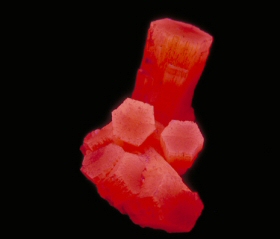
ARAGONITE, Sicily, Italy.
OL (365 nm)
Col. G.Barmarin; Photo: G. Barmarin
Photo Ondes Courtes (254nm)
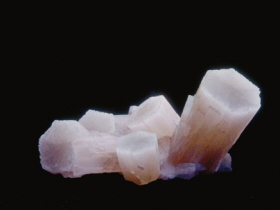
ARAGONITE, Sicily, Italy.
OC (254 nm)
Col. G.Barmarin; Photo: G. Barmarin
Galerie de photos:


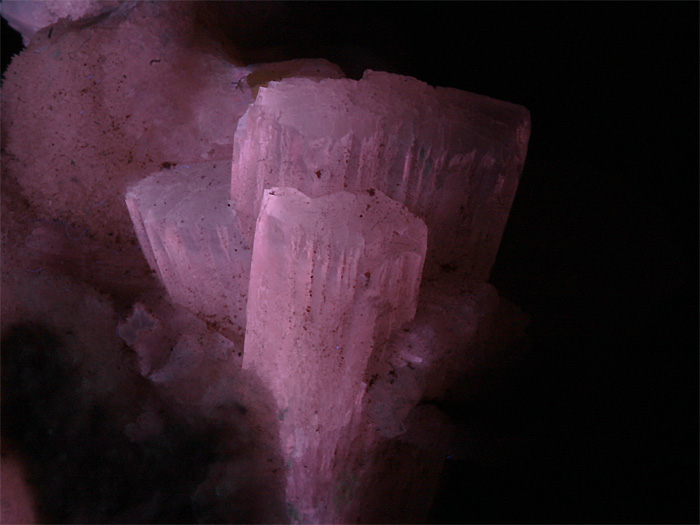
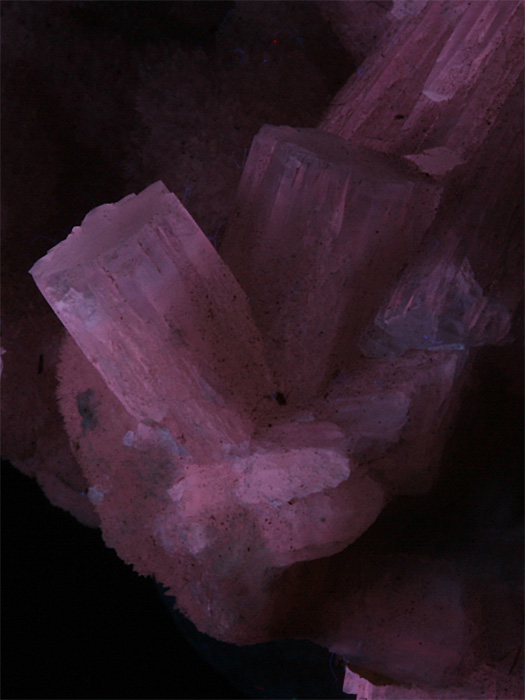 ...
...  Accès à la galerie complète (16 images au total)
Accès à la galerie complète (16 images au total)
Vous avez une photo de ce minéral que vous voudriez voir figurer dans la galerie? Contactez-nous!
Phosphorescence (au sens commun du terme) observable à l'oeil nu:
Type d'UV |
Couleur |
Intensité |
Fréquence d'observation |
|---|---|---|---|
UV longs (365nm): | Blanc verdâtre | Forte | Souvent | UV moyens (320 nm): | Blanc verdâtre | Forte | Souvent | UV courts (254 nm): | Blanc verdâtre | Forte | Souvent |
Thermoluminescence: OUI
Commentaires:
Kunz et Baskerville font remarquer que l'aragonite est souvent fluorescente lors de leur étude mémorable de 13000 spécimens de minéraux en 1903.
Activateur(s) et spectre(s):
Activateur(s): Mn2+ , (UO2)2+ (ion Uranyle) en impureté, ST (Singlet-triplet)-Matière organique en impureté, Ce3+, Sm3+, Eu3+, Dy3+, Centres dûs aux effets des radiations,
Pics dans le spectre (nm):
Sm3+ repl. Ca2+ : 603, 640nm Mn2+ : broad band at 630nm (120nm half-width) Dy3+ : 482, 486, 578, 579nm Radiation induced center : 580nm (very short decay time of approximately 20 ns)

Spectrum: Michael Gaft, Petah Tikva, Israel. Plot: Institute of Mineralogy, University of Vienna, Austria, with permission of the authors.
Galerie de spectres:
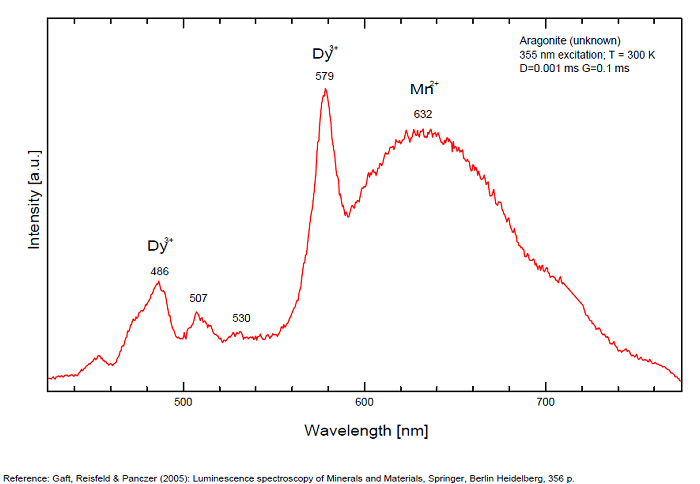

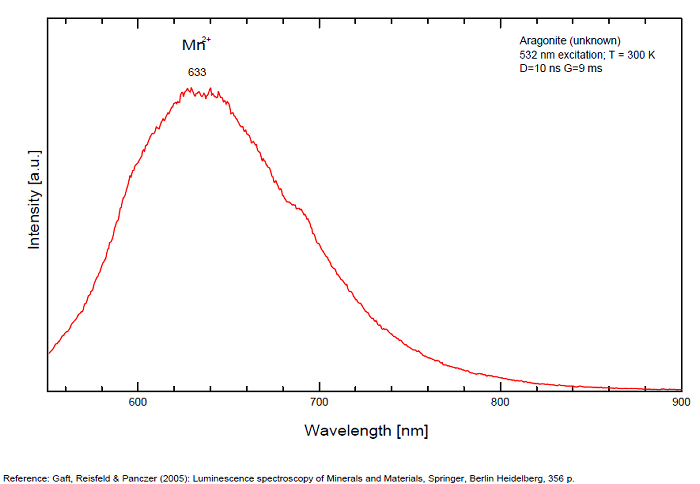
 ...
...  Accès à la galerie complète (4 images au total)
Accès à la galerie complète (4 images au total)
Commentaires sur les spectres et les activateurs (*):
Fluo green: due to U in traces; Under cw laser excitation at 532 and 780nm several bands and narrow lines have been found in visible and IR parts of the spectrum. Evidently they may be connected with another type of Mn2+, trivalent REE, such as Sm3+, Eu3+ and different types of Nd3+ centers. The origin of the broad band peaking at approximately 700 nm needs further study. The frequent occurrence of slight amounts of Strontium in aragonite was known during the time of Becquerel and he ascribed the luminescence to the presence of strontium. Later, Nichols confirmed the idea. Hence the name strontioaragonite for some specimen of very bright red fluorescing aragonite. Actually, strontium is not considered anymore as the activator responsable for the red fluorescence of aragonite and Mn and REE are considered as the principal activators of this red fluorescence.
Activators: Mn2+, Sm3+, Dy3+ (Gaft)
The broad luminescence band peaking at 580 nm with very short decay time of approximately 20 ns, could by analogy with Terlingua-type calcite may be preliminarily ascribed to radiation induced luminescence center. (Gaft)
(*)Les commentaires sur les spectres sont uniquement rédigés en Anglais
Meilleure(s) localité(s) pour la fluorescence (*):
- Strontio-aragonite: red SW and LW, Boccheggiano mines, Montieri, Grosseto Province, Tuscany, Italy;
- Aragonite fluo pink/salmon LW, white SW : Sulphur Mine near Agrigento, Agrigento Province, Sicily, Italy;
- Giumentaro Mine (Capodarso Mine), Capodarso, Enna (Castrogiovanni), Enna Province, Sicily, Italy;
- Cozzo Disi Mine, Casteltermini, Agrigento Province, Sicily, Italy;
- Nicholsonite: fluo and phospho white SW & cream LW, Zinc Mine Friedenville, Friedensville, Saucon Valley, Upper Saucon Township, Lehigh Co., Pennsylvania, USA
- Tarnowitzite:yellowish-white, strongest SW or red SW: Tsumeb Mine, Tsumeb, Otjikoto Region, Namibia;
- Tarnowitzite: Touissit, Touissit District, Jerada Province, Oriental Region, Morocco ( Straw-yellow fluorescence SW+LW);
- Aragon de Molina, Spain (Twinned xls agregated in balls);
- Tazouta, Sefrou, Sefrou Province, Fès-Boulemane Region, Morocco (Twinned xls agregated in balls, dull green SW);
- Chihuahua, Mexico (bright green SW);
- Gallo river, Molina de Aragón, Guadalajara, Castile-La Mancha, Spain (dull white SW);
- Pantoja, Toledo, Castile-La Mancha, Spain (Acicular Aragonite bright blue-white LW);
- Great Southern Mine, Red Picacho District, Wickenburg area, Yavapai Co., Arizona, USA;
- Copper Canyon, Camp Verde, Camp Verde District, Yavapai Co., Arizona, USA (aragonite pseudomorph after glauberite, cream-yellow LW, MW & SW);
- Bisbee, Warren District, Mule Mts, Cochise Co., Arizona, USA (Patches of bright green fluorescence under SW & patches of bright creamy white fluo LW);
- Long Lake Zinc Mine, Olden Township, Frontenac Co., Ontario, Canada (fluo blue SW in red fluo calcite);
(*)Les données ne sont pas exhaustives et sont limitées à quelques localités remarquables pour la fluorescence
Référence bibliographique pour la luminescence:
- The Henkel Glossary of Fluorescent Minerals, Dr. Gerhard Henkel, Published by the FMS, 1989 ,
- Fluorescence: Gems and Minerals Under Ultraviolet Light, Manuel Robbins, 1994, Geoscience Press, ISBN 0-945005-13-X ,
- The World of Fluorescent Minerals, Stuart Schneider, Schiffer Publishing, 2006, ISBN 0-7643-2544-2 ,
- Luminescence Spectroscopy of Minerals and Materials, M. Gaft, R. Reisfeld, G. Panczer, Springer Editor, ISBN: 10 3-540-21918-8 ,
- Luminescent Spectra of Minerals, Boris S. Gorobets and Alexandre A. Rogojine, Moscow, 2002 ,
- Handbook of Fluorescent Gems and Minerals, a practical guide for the gem and mineral collector, Jack de Ment, 1949 ,
Référence pour la luminescence sur internet:
- MONT-SAINT-HILAIRE, History, Geology, Mineralogy, Laszlo HORVATH, The Canadian Mineralogist, Special Publication 14, 2019
Images:
- Pantoja, Toledo, Spain (Acicular Aragonite bright blue-white LW): http://www.mindat.org/photo-100547.html
- Great Southern Mine, Arizona, USA (with calcite & fluorite): http://www.mindat.org/photo-67554.html
- Great Southern Mine, Arizona, USA (with calcite & fluorite, details): http://www.mindat.org/photo-67557.html
- Agrigento, Agrigento Province, Sicily, Italy: http://www.mindat.org/photo-415916.html
- Giumentaro Mine, Enna Province, Sicily, Italy: https://www.mindat.org/photo-504841.html
- Bisbee, Arizona, USA: http://www.mindat.org/photo-505652.html
- Long Lake Zinc Mine, Ontario, Canada:
- Nicholsonite: Zinc Mine Friedenville, Pennsylvania, USA (SW): http://www.mindat.org/photo-573241.html
- Nicholsonite: Zinc Mine Friedenville, Pennsylvania, USA (LW): http://www.mindat.org/photo-573242.html
- Nicholsonite: Zinc Mine Friedenville, Pennsylvania, USA (SW): http://www.mindat.org/photo-573244.html
- Nicholsonite: Zinc Mine Friedenville, Pennsylvania, USA (LW): http://www.mindat.org/photo-573245.html
Référence minéralogique sur internet:
 http://www.mindat.org/show.php?name=Aragonite
http://www.mindat.org/show.php?name=Aragonite
 http://webmineral.com/data/Aragonite.shtml
http://webmineral.com/data/Aragonite.shtml
Recherche sur Internet:
 Recherche d'images sur 'Google Image'
Recherche d'images sur 'Google Image'
 Recherche de documents en français sur Google
Recherche de documents en français sur Google
 Recherche de documents en toutes
langues sur Google
Recherche de documents en toutes
langues sur Google
Une requête ne donnant pas de résultat signifie uniquement qu'aucune référence de ce type n'existe dans la base mais en aucun cas qu'elle n'existe pas dans l'absolu. Si vous considérez avoir trouvé une erreur ou une omission, merci de nous le signaler via la page contact en n'oubliant pas de citer la source de l'information.
